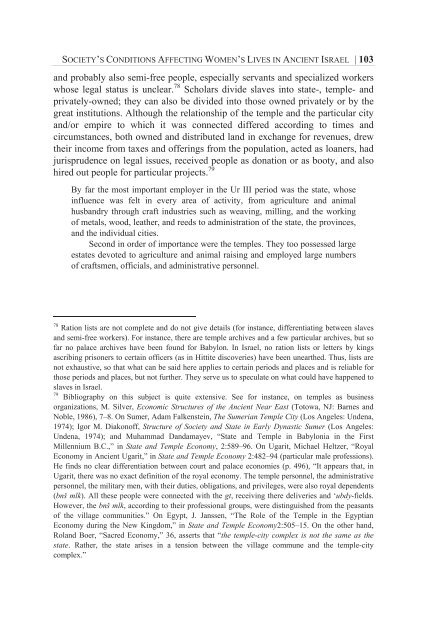Women at Work in the Deuteronomistic History - International Voices ...
Women at Work in the Deuteronomistic History - International Voices ...
Women at Work in the Deuteronomistic History - International Voices ...
Create successful ePaper yourself
Turn your PDF publications into a flip-book with our unique Google optimized e-Paper software.
SOCIETY’S CONDITIONS AFFECTING WOMEN’S LIVES IN ANCIENT ISRAEL | 103<br />
and probably also semi-free people, especially servants and specialized workers<br />
whose legal st<strong>at</strong>us is unclear. 78 Scholars divide slaves <strong>in</strong>to st<strong>at</strong>e-, temple- and<br />
priv<strong>at</strong>ely-owned; <strong>the</strong>y can also be divided <strong>in</strong>to those owned priv<strong>at</strong>ely or by <strong>the</strong><br />
gre<strong>at</strong> <strong>in</strong>stitutions. Although <strong>the</strong> rel<strong>at</strong>ionship of <strong>the</strong> temple and <strong>the</strong> particular city<br />
and/or empire to which it was connected differed accord<strong>in</strong>g to times and<br />
circumstances, both owned and distributed land <strong>in</strong> exchange for revenues, drew<br />
<strong>the</strong>ir <strong>in</strong>come from taxes and offer<strong>in</strong>gs from <strong>the</strong> popul<strong>at</strong>ion, acted as loaners, had<br />
jurisprudence on legal issues, received people as don<strong>at</strong>ion or as booty, and also<br />
hired out people for particular projects. 79<br />
By far <strong>the</strong> most important employer <strong>in</strong> <strong>the</strong> Ur III period was <strong>the</strong> st<strong>at</strong>e, whose<br />
<strong>in</strong>fluence was felt <strong>in</strong> every area of activity, from agriculture and animal<br />
husbandry through craft <strong>in</strong>dustries such as weav<strong>in</strong>g, mill<strong>in</strong>g, and <strong>the</strong> work<strong>in</strong>g<br />
of metals, wood, le<strong>at</strong>her, and reeds to adm<strong>in</strong>istr<strong>at</strong>ion of <strong>the</strong> st<strong>at</strong>e, <strong>the</strong> prov<strong>in</strong>ces,<br />
and <strong>the</strong> <strong>in</strong>dividual cities.<br />
Second <strong>in</strong> order of importance were <strong>the</strong> temples. They too possessed large<br />
est<strong>at</strong>es devoted to agriculture and animal rais<strong>in</strong>g and employed large numbers<br />
of craftsmen, officials, and adm<strong>in</strong>istr<strong>at</strong>ive personnel.<br />
78 R<strong>at</strong>ion lists are not complete and do not give details (for <strong>in</strong>stance, differenti<strong>at</strong><strong>in</strong>g between slaves<br />
and semi-free workers). For <strong>in</strong>stance, <strong>the</strong>re are temple archives and a few particular archives, but so<br />
far no palace archives have been found for Babylon. In Israel, no r<strong>at</strong>ion lists or letters by k<strong>in</strong>gs<br />
ascrib<strong>in</strong>g prisoners to certa<strong>in</strong> officers (as <strong>in</strong> Hittite discoveries) have been unear<strong>the</strong>d. Thus, lists are<br />
not exhaustive, so th<strong>at</strong> wh<strong>at</strong> can be said here applies to certa<strong>in</strong> periods and places and is reliable for<br />
those periods and places, but not fur<strong>the</strong>r. They serve us to specul<strong>at</strong>e on wh<strong>at</strong> could have happened to<br />
slaves <strong>in</strong> Israel.<br />
79 Bibliography on this subject is quite extensive. See for <strong>in</strong>stance, on temples as bus<strong>in</strong>ess<br />
organiz<strong>at</strong>ions, M. Silver, Economic Structures of <strong>the</strong> Ancient Near East (Totowa, NJ: Barnes and<br />
Noble, 1986), 7–8. On Sumer, Adam Falkenste<strong>in</strong>, The Sumerian Temple City (Los Angeles: Undena,<br />
1974); Igor M. Diakonoff, Structure of Society and St<strong>at</strong>e <strong>in</strong> Early Dynastic Sumer (Los Angeles:<br />
Undena, 1974); and Muhammad Dandamayev, “St<strong>at</strong>e and Temple <strong>in</strong> Babylonia <strong>in</strong> <strong>the</strong> First<br />
Millennium B.C.,” <strong>in</strong> St<strong>at</strong>e and Temple Economy, 2:589–96. On Ugarit, Michael Heltzer, “Royal<br />
Economy <strong>in</strong> Ancient Ugarit,” <strong>in</strong> St<strong>at</strong>e and Temple Economy 2:482–94 (particular male professions).<br />
He f<strong>in</strong>ds no clear differenti<strong>at</strong>ion between court and palace economies (p. 496), “It appears th<strong>at</strong>, <strong>in</strong><br />
Ugarit, <strong>the</strong>re was no exact def<strong>in</strong>ition of <strong>the</strong> royal economy. The temple personnel, <strong>the</strong> adm<strong>in</strong>istr<strong>at</strong>ive<br />
personnel, <strong>the</strong> military men, with <strong>the</strong>ir duties, oblig<strong>at</strong>ions, and privileges, were also royal dependents<br />
(bnš mlk). All <strong>the</strong>se people were connected with <strong>the</strong> gt, receiv<strong>in</strong>g <strong>the</strong>re deliveries and ‘ubdy-fields.<br />
However, <strong>the</strong> bnš mlk, accord<strong>in</strong>g to <strong>the</strong>ir professional groups, were dist<strong>in</strong>guished from <strong>the</strong> peasants<br />
of <strong>the</strong> village communities.” On Egypt, J. Janssen, “The Role of <strong>the</strong> Temple <strong>in</strong> <strong>the</strong> Egyptian<br />
Economy dur<strong>in</strong>g <strong>the</strong> New K<strong>in</strong>gdom,” <strong>in</strong> St<strong>at</strong>e and Temple Economy2:505–15. On <strong>the</strong> o<strong>the</strong>r hand,<br />
Roland Boer, “Sacred Economy,” 36, asserts th<strong>at</strong> “<strong>the</strong> temple-city complex is not <strong>the</strong> same as <strong>the</strong><br />
st<strong>at</strong>e. R<strong>at</strong>her, <strong>the</strong> st<strong>at</strong>e arises <strong>in</strong> a tension between <strong>the</strong> village commune and <strong>the</strong> temple-city<br />
complex.”




